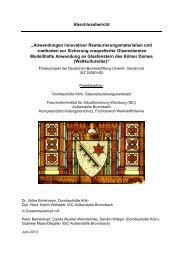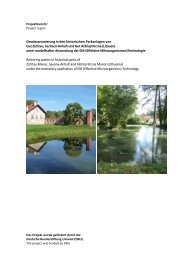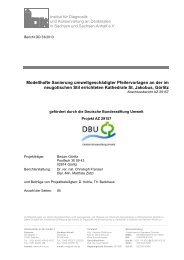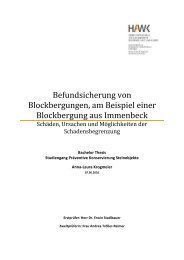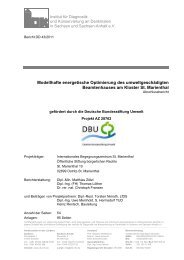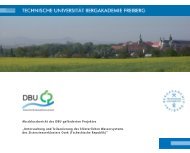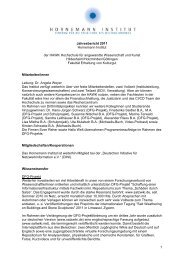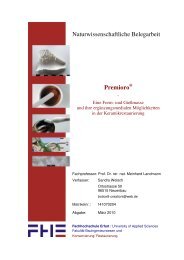Download PDF
Download PDF
Download PDF
Erfolgreiche ePaper selbst erstellen
Machen Sie aus Ihren PDF Publikationen ein blätterbares Flipbook mit unserer einzigartigen Google optimierten e-Paper Software.
Weichmacherverlust bei PVC-Objekten von Joseph Beuys – Versuche zu kurativen und konservatorischen Massnahmen<br />
ANHANG III: ZUSAMMENSTELLUNG VON ABSTRACTS<br />
Substitution<br />
Lakshmi, S.; Jayakrishnan, A. (2003): Properties and performance of sulfide-substituted plasticized<br />
poly(vinyl chloride) as a biomaterial. In: Journal of Biomedical Materials Research, Volume 65B, Issue 1, Date:<br />
15 April 2003, S. 204-210<br />
Plasticized poly(vinyl chloride) (PVC) was surface modified by nucleophilic substitution of the chlorine atoms of PVC<br />
by sulfide ions in aqueous media in the presence of a phase-transfer catalyst (PTC) to make it migration resistant.<br />
The modified PVC was sterilized by steam autoclaving and gamma radiation and subjected to plasticizer extraction in<br />
an extraction medium such as hexane. Virtually no plasticizer migrated out of modified PVC into the medium even<br />
after prolonged incubation for 30 d. The properties of the modified surface were evaluated by contact angle<br />
measurements, scanning electron microscopy (SEM), cell-culture studies, hemolysis assay, and whole-blood clotting<br />
time measurements. The mechanical properties of modified sheets were evaluated by measurements of tensile<br />
strength and strain at break after subjecting the specimens to different modes of sterilization. The modified PVC<br />
surface showed enhanced wettability and was found to be non-hemolytic and non-cytotoxic. Whole-blood clotting<br />
profiles of unmodified and modified PVC were virtually the same. Modification imparted slight yellow color to the<br />
material. Surface modification resulted in an 8% decrease in the ultimate stress and 28% decrease in the strain at<br />
break values. The sulfide-substituted PVC was found to be blood compatible and would be useful in applications<br />
such as tubing for transfusion, dialysis etc., where migration resistance is important.<br />
Reyes-Labarta, Juan; Herrero, Miguel; Tiemblo, Pilar; Mijangos, Carmen; Reinecke, Helmut (2003): Wetchemical<br />
surface modification of plasticized PVC. Characterization by FTIR-ATR and Raman microscopy. In:<br />
Polymer, vol. 44, issue 8, April 2003, S. 2263-2269<br />
The chemical modification of plasticized PVC films with amino thiophenol in mixtures of DMF/H20 has been studied.<br />
The degree of modification and the distribution of modified groups within the films were determined using Raman<br />
spectroscopy and FTIR-ATR. The amounts of plasticizer (bis-2-ethylhexyl phtalate, DOP) bleached out during the<br />
reaction and the amount of dimethylformamide (DMF) penetrated into the film were analysed in control reactions<br />
without the reactant using 1H NMR spectroscopy and Raman spectroscopy.<br />
Reaction kinetics and surface selectivity of the modification reaction were compared with the corresponding<br />
reactions of PVC films without plasticizer.<br />
Lakshmi, S.; Jayakrishnan, A. (2002): Iodination of plasticized poly(vinyl chloride) in aqueous media via<br />
phase transfer catalysis. In: Journal of Applied Polymer Science, Volume 84, Issue 3, Date: 18 April 2002, S.<br />
493-499<br />
Nucleophilic substitution of chlorine on plasticized poly(vinyl chloride) (PVC) was carried out using potassium iodide<br />
(KI) in the presence of a phase transfer catalyst (PTC) in aqueous media. Iodination was confirmed using energy<br />
dispersive X-ray analysis (EDAX). The extent of iodination was studied with respect to time, temperature,<br />
concentration of the reactants, as well as different PTCs. Among the different PTCs examined, tetrabutylammonium<br />
bromide (TBAB) and tetrabutylammonium hydrogen sulfate (TBAH) were found to be highly efficient for the reaction.<br />
About 25% increase in weight was observed for PVC sheets iodinated under optimal reaction conditions. The<br />
thermal stability of the modified PVC was found to be impaired upon iodination. The iodinated PVC released iodide<br />
ions when kept in distilled water, as evidenced by UV spectroscopy. Sustained release of iodide ion in distilled water<br />
was followed up for about 30 days. © 2002 Wiley Periodicals, Inc. J Appl Polym Sci 84: 493-499, 2002; DOI<br />
10.1002/app.10176




